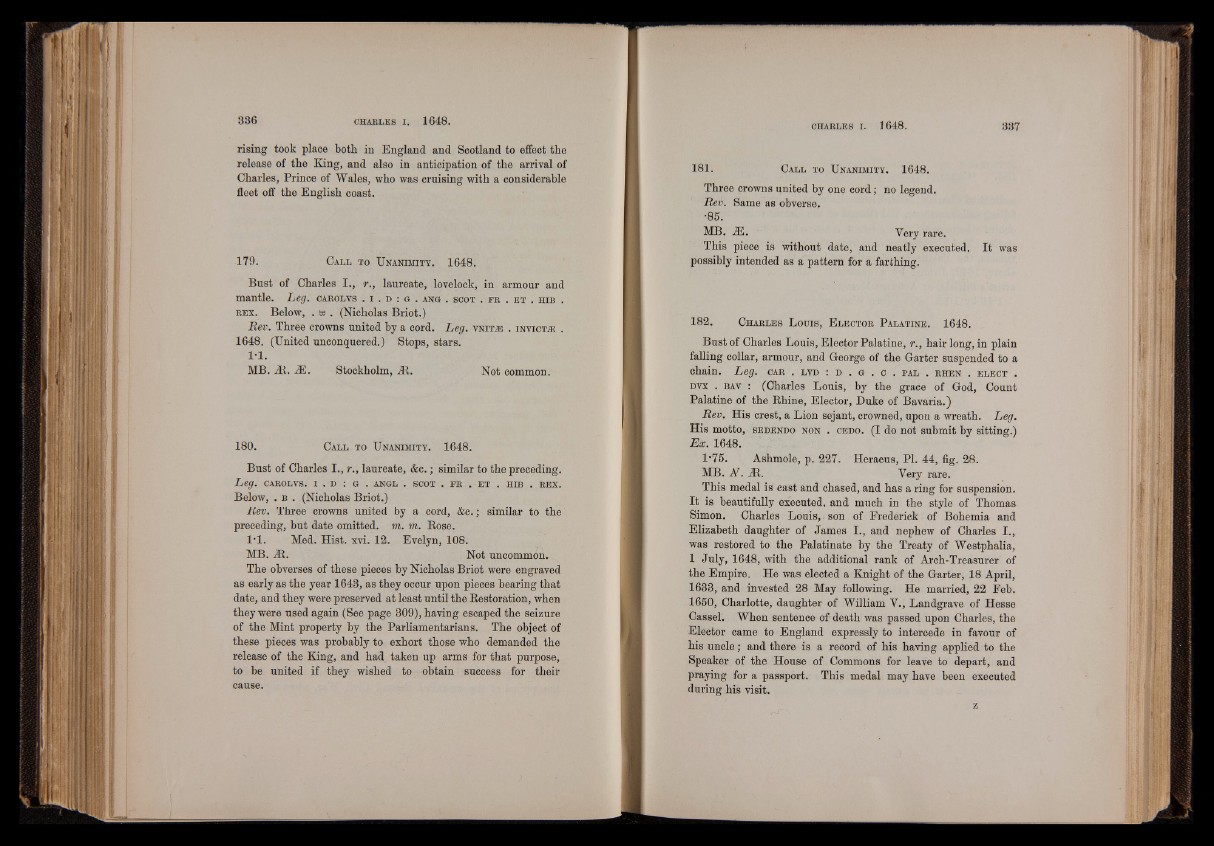
rising took place both in England and Scotland to effect the
release of the King, and also in anticipation of the arrival of
Charles, Prince of Wales, who was cruising with a considerable
fleet off the English coast.
179. C a l l to U n a n im ity . 1648.
Bust of Charles I., r., laureate, lovelock, in armour and
mantle. Leg. oarolvs . i . d : g . ang . scot . f r . e t . h ib .
r e x . Below, . w . (Nicholas Briot.)
Rev. Three crowns united b y a cord. Leg. v n it je . in v ic l e .
1648. (United unconquered.) Stops, stars.
1-1.
MB. .11. /II. Stockholm, /ll. Not common.
180. Ca l l to U n a n im ity . 1648.
Bust of Charles I., r., laureate, &c.; similar to the preceding.
Leg. carolvs. i . d : g . angl . scot . f r . e t . h ib . r e x .
Below, . b . (Nicholas Briot.)
Rev. Three crowns united by a cord, &c.; similar to the
preceding, but date omitted, m. m. Kose.
1*1. Med. Hist. xvi. 12. Evelyn, 108.
MB. .51. Not uncommon.
The obverses of these pieces by Nicholas Briot were engraved
as early as the year 1643, as they occur upon pieces bearing that
date, and they were preserved at least until the Restoration, when
they were used again (See page 309), having escaped the seizure
of the Mint property by the Parliamentarians. The object of
these pieces was probably to exhort those who demanded the
release of the King, and had taken up arms for that purpose,
to be united if they wished to obtain success for their
cause.
181. C a l l to U n a n im ity . 1648.
Three crowns united by one cord; no legend.
Rev. Same as obverse.
•85.
MB. M. Very rare.
This piece is without date, and neatly executed. It was
possibly intended as a pattern for a farthing.
182. C h a r l e s L o u is , E l e c t o r P a l a t in e . 1648.
Bust of Charles Louis, Elector Palatine, r., hair long, in plain
falling collar, armour, and George of the Garter suspended to a
chain. Leg. car . lvd : d . g . c . pa l . r h e n . e l e c t .
dvx . bav : (Charles Louis, by the grace of God, Count
Palatine of the Rhine, Elector, Duke of Bavaria.)
Rev. His crest, a Lion sejant, crowned, upon a wreath. Leg.
His motto, s e d e n d o non . c ed o . (I do not submit by sitting.)
Ex. 1648.
1*75. Ashmole, p. 227. Heraeus, PI. 44, fig. 28.
MB. N . iR. Very rare.
This medal is cast and chased, and has a ring for suspension.
It is beautifully executed, and much in the style of Thomas
Simon. Charles Louis, . son of Frederick of Bohemia and
Elizabeth daughter of James I., and nephew of Charles I.,
was restored to the Palatinate by the Treaty of Westphalia,
1 July, 1648, with the additional rank of Arch-Treasurer of
the Empire. He was elected a Knight of the Garter, 18 April,
1633, and invested 28 May following. He married, 22 Feb.
1650, Charlotte, daughter of William V., Landgrave of Hesse
Cassel. When sentence of death was passed upon Charles, the
Elector came to England expressly to intercede in favour of
his uncle; and there is a record of his having applied to the
Speaker of the House of Commons for leave to depart, and
praying for a passport. This medal may have been executed
during his visit.
z